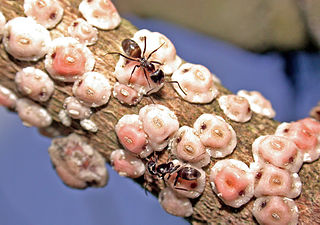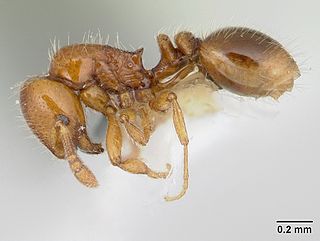Related Research Articles

Dolichoderinae is a subfamily of ants, which includes species such as the Argentine ant, the erratic ant, the odorous house ant, and the cone ant. The subfamily presents a great diversity of species throughout the world, distributed in different biogeographic realms, from the Palearctic, Nearctic, Afrotropical region and Malaysia, to the Middle East, Australian, and Neotropical regions.

Amyrmex golbachi is a rare Neotropical species of ant and the only known species in the genus Amyrmex. It is currently only known from males from the Amazon basin of Brazil and from northern Argentina.

Dorymyrmex is a genus of ants in the subfamily Dolichoderinae.

Leptomyrmex, or spider ants, is a genus of ants and a distinctive member of the ant subfamily Dolichoderinae. Commonly known as "spider ants" for their long legs and spider-like movements, these orange and black ants are prominent residents of intact wet forest and sclerophyll habitats throughout their range. One extant species, Leptomyrmex relictus, is known from central Brazil; otherwise, the global distribution of this genus is restricted to eastern Australia, New Caledonia and New Guinea, as well as the nearby Indonesian islands of Aru and Seram.

Oxyepoecus is a Neotropical genus of ant in the subfamily Myrmicinae. The genus is a member of the tribe Solenopsidini and currently includes 20 species.

Gracilidris is a genus of dolichoderine ants with nocturnal behaviour; thought to have gone extinct 15-20 million years ago, they have been found in Paraguay, Brazil, and Argentina and were described in 2006.

Ochetellus is a genus of ants first described by Steve Shattuck in 1992. He placed it in the subfamily Dolichoderinae of the family Formicidae. The ants in this genus are small and black in colour; workers measure 1.75 to 3 millimetres in length, the males at around 1.6 millimetres (0.06 in) are smaller, and the queens are the largest, reaching 4 millimetres (0.16 in). There are seven described species and three described subspecies that mostly live in Australia in a wide variety of habitats, but some species are found in Asia. One species, Ochetellus glaber, has been introduced into New Zealand and the United States.

Aulacopone is a genus of ant in the subfamily Heteroponerinae containing the single species Aulacopone relicta. The genus was described by Arnoldi (1930) from a unique dealate female collected at Ələzəpin (Alazapin), near Lankaran, in Azerbaijan S.S.R., Soviet Union, near its border with Iran. The specimen was taken in galleries of the formicine ant Lasius emarginatus, under the bark of an oak stump, in mid-montane forest.

Sphinctomyrmex is a genus of ants in the subfamily Dorylinae. The genus is a pantropical and distinctive group, originally described by Mayr based on a single gyne collected in Brazil. Morphologically, the genus is characterized by the unique arrangement of the gastric segments, which are nearly equal in length and separated from each other by distinct constrictions. Very little is known on the natural history of Sphinctomyrmex. The few observations so far suggest that ants of this genus are nomadic predators of other ants.

Lenomyrmex is a Neotropical genus of ant in the subfamily Myrmicinae.
Sphinctomyrmex marcoyi is a Neotropical species of ants in the subfamily Dorylinae. It is the only Sphinctomyrmex species recorded in the Amazon Forest. Gynes and males are unknown.

Sphinctomyrmex stali is a Neotropical species of ants in the subfamily Dorylinae. Mayr described the genus Sphinctomyrmex with S. stali as its type species, based on a single dealate gyne. However, except for the holotype, there are no records of normal (alate) gynes for S. stali. All reproductive females collected after the original description are ergatoids.
Sphinctomyrmex schoerederi is a Neotropical species of ants in the subfamily Dorylinae. S. schoerederi is known only from the holotype, collected in a leaf litter sample from a forest remnant in the campus of Universidade Federal de Viçosa in Brazil, where it occurs in sympatry with S. stali. Gynes and males are unknown.

Slave-making ants are brood parasites that capture broods of other ant species to increase the worker force of their colony. After emerging in the slave-maker nest, slave workers work as if they were in their own colony, while parasite workers only concentrate on replenishing the labor force from neighboring host nests, a process called slave raiding.
Gracilidris humiloides is an extinct species of ant in the genus Gracilidris. It was discovered in the Dominican amber, only known from a single specimen, described by Wilson in 1985.
Dorymyrmex tuberosus is a species of ant in the genus Dorymyrmex. Described by Cuezzo and Guerrero in 2011, the species is endemic to Colombia.
Dorymyrmex xerophylus is a species of ant in the genus Dorymyrmex. Described by Cuezzo and Guerrero in 2011, the species is endemic to Colombia.

Novomessor albisetosus, also known as the desert harvester ant, is a species of ant found in the United States and Mexico. A member of the genus Novomessor in the subfamily Myrmicinae, it was first described by Austrian entomologist Gustav Mayr in 1886. It was originally placed in the genus Aphaenogaster, but a recent phylogenetic study concluded that it is genetically distinct and should be separated. It is a medium-sized species, measuring 6 to 8.5 millimeters and has a ferruginous body color. It can be distinguished from other Novomessor species by its shorter head and subparallel eyes.
References
- 1 2 Cuezzo, F.; Guerrero, R. J. (2012). "The Ant Genus Dorymyrmex Mayr (Hymenoptera: Formicidae: Dolichoderinae) in Colombia" (PDF). Psyche: A Journal of Entomology. 2012: 1–24. doi: 10.1155/2012/516058 .
-
 This article incorporates text from a scholarly publication published under a copyright license that allows anyone to reuse, revise, remix and redistribute the materials in any form for any purpose: Cuezzo, F.; Guerrero, R. J. (2012). "The Ant Genus Dorymyrmex Mayr (Hymenoptera: Formicidae: Dolichoderinae) in Colombia" (PDF). Psyche: A Journal of Entomology. 2012: 1–24. doi: 10.1155/2012/516058 . Please check the source for the exact licensing terms.
This article incorporates text from a scholarly publication published under a copyright license that allows anyone to reuse, revise, remix and redistribute the materials in any form for any purpose: Cuezzo, F.; Guerrero, R. J. (2012). "The Ant Genus Dorymyrmex Mayr (Hymenoptera: Formicidae: Dolichoderinae) in Colombia" (PDF). Psyche: A Journal of Entomology. 2012: 1–24. doi: 10.1155/2012/516058 . Please check the source for the exact licensing terms.